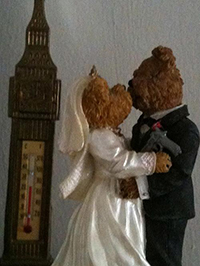We came up with many great radio show ideas this past week. You can see them all at the link, at least the ones that were tagged properly. A number of people mentioned fashion as a topic. This poses a challenge in that fashion is very visual, whereas we will only have sound and dialogue to work with. And we wouldn’t want the show to just be people talking about clothes. We would need to find a way to use sound to make it compelling. I can imagine the sounds of a fashion show – the murmur of the crowd, the cameras clicking and winding, the music, footsteps on the catwalk. The way voices sound in a large room or hall. A show might take the form of a news broadcast, with theme music transitioning between segments and some sort of storyline running through it. Or it could be a murder mystery at a fashion show, just creating a simple plot to draw the listener in to a discussion of fashion. Here are some other thoughts from the past week:
The book review idea is novel and has great potential. I could imagine taking 80s books that have been made into video, like Handmaids Tale, Jason Bourne, Stephen King, Tom Clancy, and weaving dialogue clips together with analysis of themes to create a story. The key is to find ways to use sounds to drive the story. Another idea that has come up is politics of the 80s, although people tend to think it doesn’t fit the pop culture aspect. But pop culture can both reflect and drive politics, so it could work. Audio clips from speeches, newscasts and interviews could be woven in to make the show sonically compelling.
And speaking of weaving sounds:
This is s simple write-up, but it clearly shows what was used and how it was put together. The power of Audacity, like the power of Photoshop, is in the layers. You can see it at work here.
The Internet Archive has an Internet Arcade full of games from the 80s. I have no idea how to make a story out of it, but then I’m not a gamer. Maybe we could imagine being caught inside games, and work the game sounds into the story. Games, like fashion, are very visual, but they have their sounds too, as do arcades.
I think we take sound for granted, and rarely if ever think about how it functions in media. We’ve done experiments in the past where we listened to videos on ds106radio for our live tweeting sessions. It’s interesting to see just how much of the story you can get just from the sound – much more than you would in the reverse, from watching the video with no sound. Obviously dialogue plays a huge role in that difference, but the background sounds give so much information about the setting and the action. For example, I heard a sound editor talk about how to make scenes quiet. You can’t turn the sound off, because that would make it seem like it was broken, a technical problem. The way to do it is to add sounds in, to amplify those little sounds you wouldn’t hear outside of a quiet situation. If it’s supposed to be so quiet you could hear a pin drop, amplify the sound of the pin.
As I said following the broadcasts, I hope people got some ideas on how they might use sound to drive stories from the listening and analyzing exercises. We’ll be creating our own audio productions soon, so we can use these ideas to think about how we can use sound to tell our stories.


